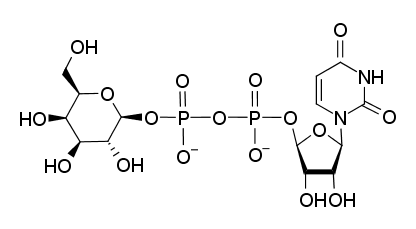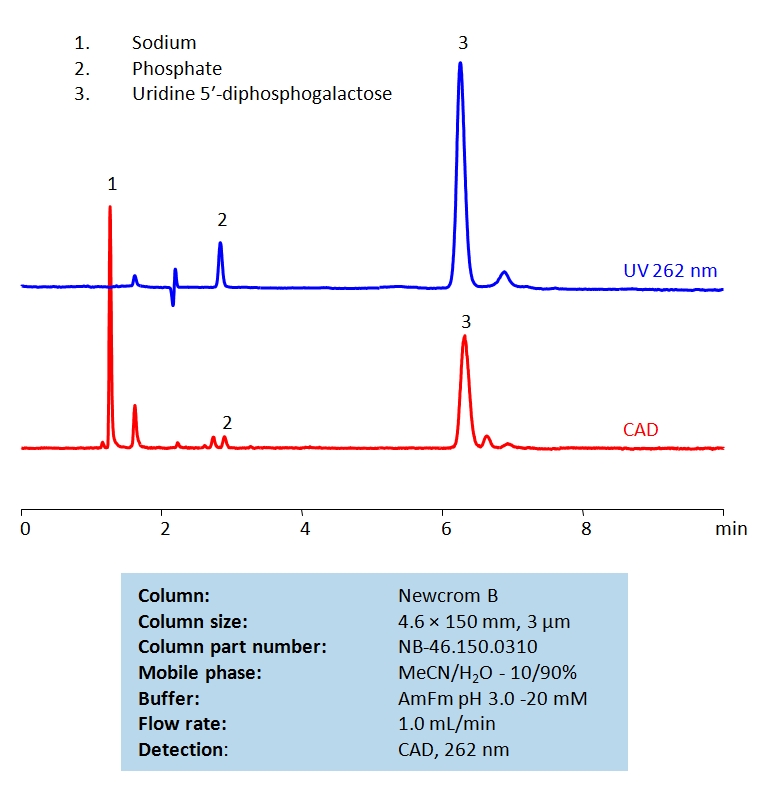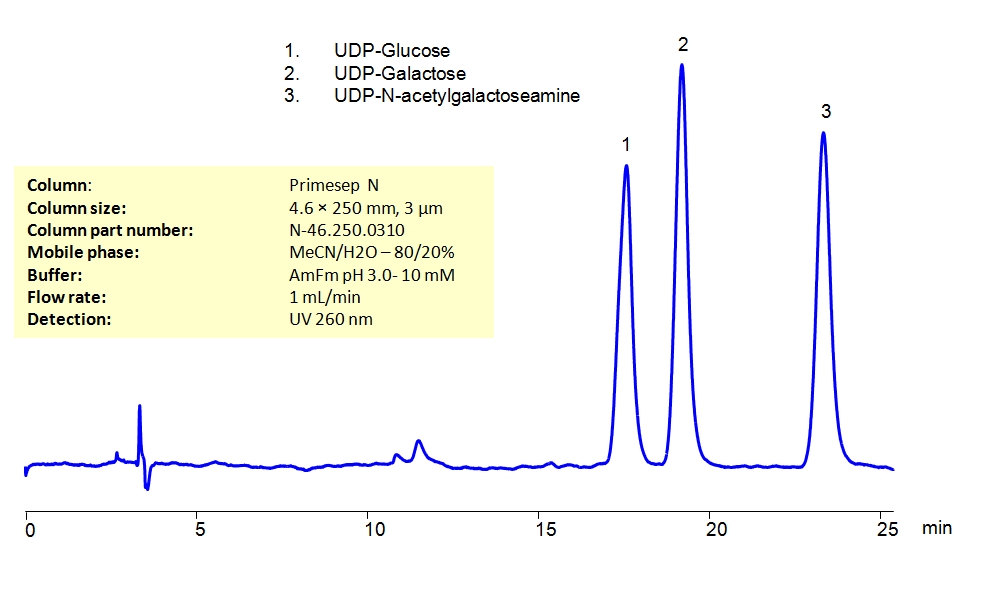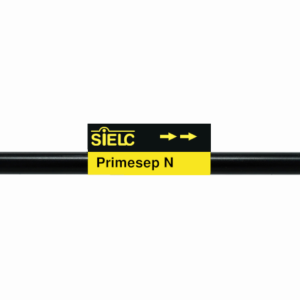| CAS Number | 28053-08-9 |
|---|---|
| Molecular Formula | C15H22N2Na2O17P2 |
| Molecular Weight | 610.27 |
| InChI Key | PKJQEQVCYGYYMM-OUJOOSCPSA-L |
| Synonyms |
|
Applications:
HPLC Determination of Uridine Diphosphate Galactose on Newcrom B Column
May 13, 2021
HPLC Method for Uridine 5'-diphosphogalactose disodium salt on Newcrom B by SIELC Technologies
High Performance Liquid Chromatography (HPLC) Method for Analysis of Uridine 5'-diphosphogalactose disodium salt.
Uridine Diphosphate Galactose (UDP-galactose) is an intermediary formed in the biosynthesis of polysaccharides with the chemical formula C15H24N2O17P2. It is important in glycolysis, which is a metabolic pathway that converts glucose into pyruvate.
UDP-galactose can be detected in the low UV regime. Using a Newcrom B mixed-mode column and a mobile phase consisting of water and acetonitrile (MeCN) with an ammonium formate (AmFm) buffer, UDP-galactose can be retained and separated. This analysis method can be UV detected at 265 nm, or via charged aerosol detection (CAD), both with high resolution.
| Column | Newcrom B, 4.6 x 150 mm, 3 µm, 100 A, dual ended |
| Mobile Phase | MeCN/H2O – 10/90% |
| Buffer | AmFm – pH 3.0 – 20 mm |
| Flow Rate | 1.0 ml/min |
| Detection | CAD, 262 nm |
| Class of Compounds |
Sugar Phosphate |
| Analyzing Compounds | Uridine 5'-diphosphogalactose disodium salt |
Application Column
Newcrom B
Column Diameter: 4.6 mm
Column Length: 150 mm
Particle Size: 3 µm
Pore Size: 100 A
Column options: dual ended

HPLC Separation of Uridine Sugar Diphospates on Primesep N Column
May 11, 2021
HPLC Method for Uridine-5'-diphosphate-glucose, Uridine 5'-diphosphogalactose disodium salt, Uridine 5′-diphospho-N-acetylgalactosamine on Primesep N by SIELC Technologies
High Performance Liquid Chromatography (HPLC) Method for Analysis of Gadolinium-DOTA
Uridine sugar diphospates are a class of complex nucleotide sugars that are integral to metabolic processes in the cell. Uridine diphosphate galactose (UDP-Galactose), Uridine diphosphate glucose (UDP-Glucose), and uridine diphosphate N-acetylglucosamine (UDP-N-acetylgalactoseamine or UDP-GlcNAc) are some of the most well-known nucleotide sugars.
Uridine Diphosphate Glucose (UDP-glucose) is an an important nucleotide sugar with the chemical formula C15H24N2O17P2. It is involved in metabolic processes in the cell. It is a precursor to glycogen, UDP-galactose, and UDP-glucuronic acid, as well as other polysacchrides and glycosphingolipids.
Uridine Diphosphate Galactose (UDP-galactose) is an intermediary formed in the biosynthesis of polysaccharides with the chemical formula C15H24N2O17P2. It is important in glycolysis, which is a metabolic pathway that converts glucose into pyruvate.
These three uridine sugar diphosphate compounds can be detected in the low UV regime. Using a Primesep N normal-phase column and a mobile phase consisting of water and acetonitrile (MeCN) with an ammonium formate (AmFm) buffer, UDP-galactose, UDP-glucose, and UDP-GIcNAc can be retained, separated, and analyzed. This analysis method can be UV detected at 260 nm.
| Column | Primesep N, 4.6 x 250 mm, 3 µm, 100 A, dual ended |
| Mobile Phase | MeCN – 80% |
| Buffer | Ammonium formate pH 3.0 – 10 mM |
| Flow Rate | 1.0 ml/min |
| Detection | UV 260 nm |
| Class of Compounds | Sugar, Phospate |
| Analyzing Compounds | Uridine-5'-diphosphate-glucose, Uridine 5'-diphosphogalactose disodium salt, Uridine 5′-diphospho-N-acetylgalactosamine |
Application Column
Primesep N
Column Diameter: 4.6 mm
Column Length: 250 mm
Particle Size: 3 µm
Pore Size: 100 A
Column options: dual ended
Uridine 5′-diphospho-N-acetylgalactosamine
Uridine-5′-diphosphate-glucose






